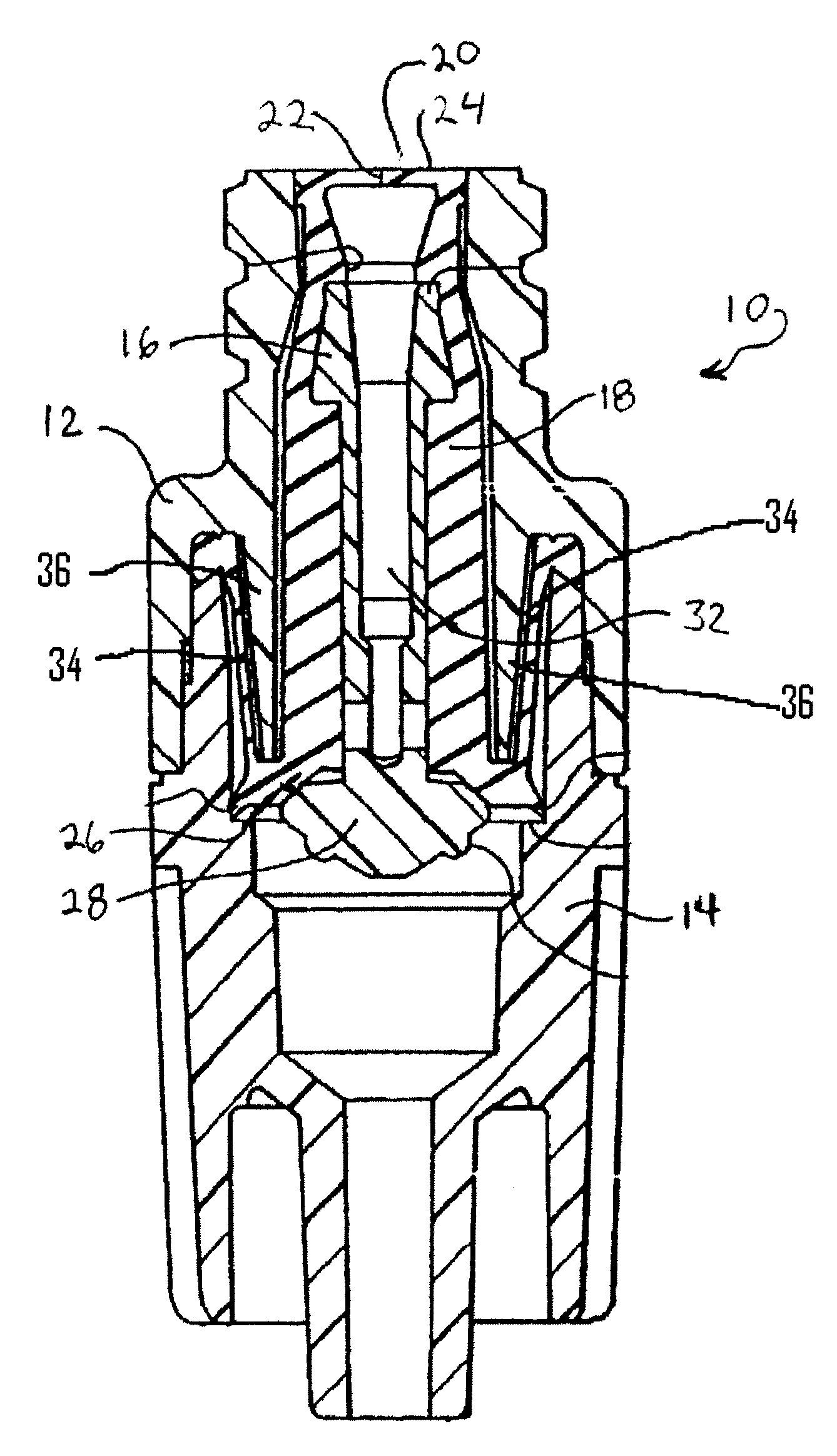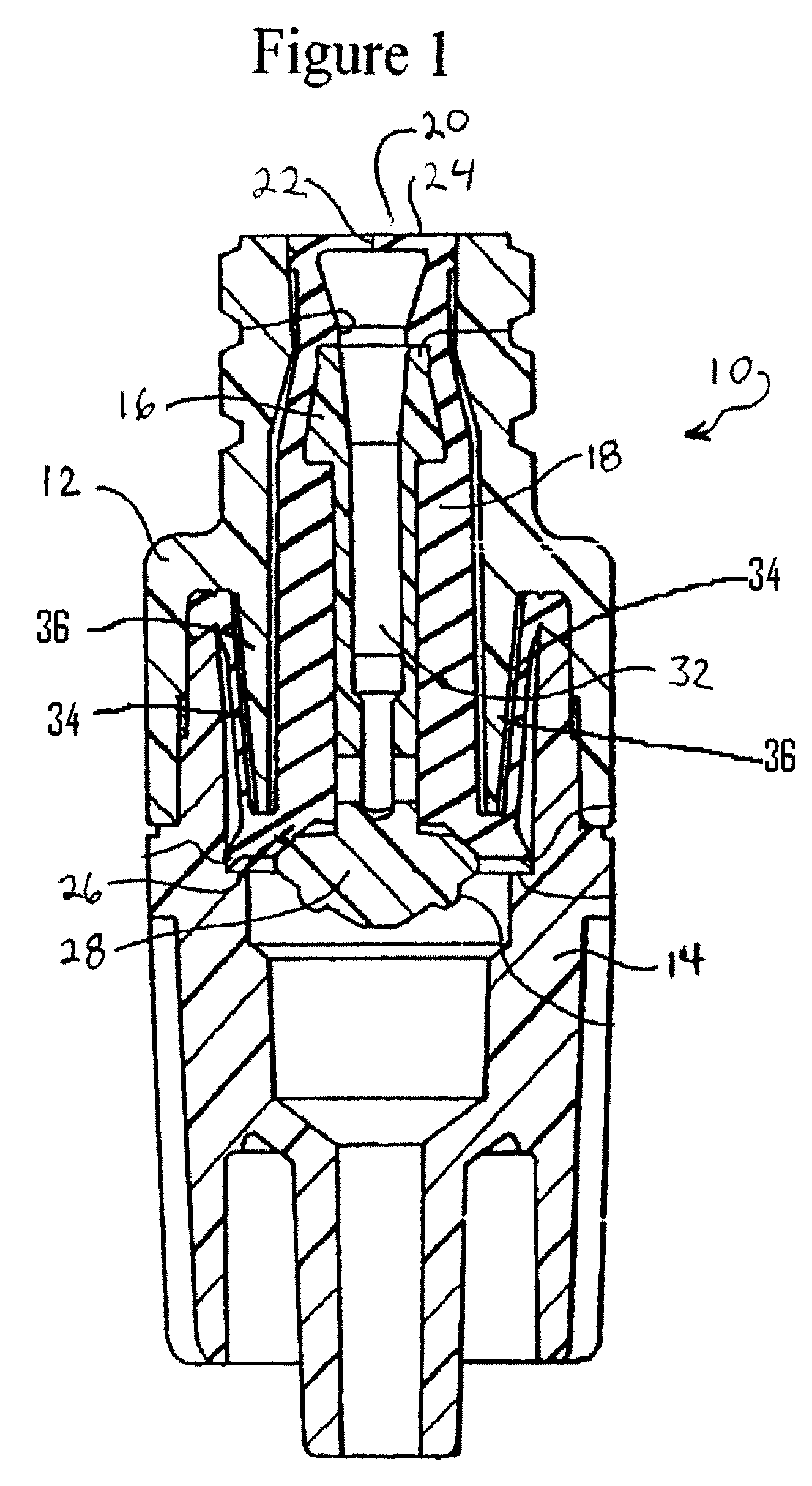Lubricious or/and wettable or/and anti-thrombin elastomeric gland materials in luer activated devices
a technology of lubricating or wettable or antithrombin elastomeric glands and activated devices, which is applied in the direction of mechanical devices, other medical devices, couplings, etc., can solve the problems of gland sticking down, valve failure, gland sticking down, etc., and achieve the effect of increasing the wettability of the gland and preventing clotting
- Summary
- Abstract
- Description
- Claims
- Application Information
AI Technical Summary
Benefits of technology
Problems solved by technology
Method used
Image
Examples
example 1
[0039]In order to determine the functional attributes of the additive enhanced glands, a number of plaques of an elastomeric substrate typically used in making glands of LADs were made incorporating one or more additives along with a control having no additive.
[0040]The following table identifies the additives and testing performed:
[0041]
Testing# ofC.O.FWettingBloodTensile bar% byplaquesvs.contactClottingtesting afterMaterialMix #Additivesweightto makeTimeangleTendencygammare-knit1No Additives / Control0.05XXXXXGroup2FL-100 fluorosilicone3.04XXX(100 cs)3DC550 phenyl silicone3.04XXX(125 cs)4MED 400 fluorosilicone1.02XX(1000 cs)5MED 400 fluorosilicone3.04XXX(1000 cs)6MED 400 fluorosilicone5.04XXX(1000 cs)7L-77 polysiloxane1.02Xpolyether copolymer (20 cs)8L-77 polysiloxane3.05XXXXpolyether copolymer (20 cs)9DC5324 polysiloxane1.02Xpolyether copolymer(350 cs)10DC5324 polysiloxane3.05XXXXpolyether copolymer(350 cs)11DC193 polysiloxane1.02Xpolyether copolymer(335 cs)12DC193 polysiloxane3.05...
example 2
[0056]Some of the mixes of Example 1, specifically mixes 1-7, 16 and 17 were also tested to determine the effect of the lubricant additive on molecular cross-linking or re-knit of the silicone substrate.
[0057]For each mix tested, six rectangles were cut from the plaque with each rectangle measuring 3 inch×1 inch. Two of the rectangular samples were stacked together, so that a double-thick 3 inch×1 inch sample is formed. Wax paper was placed between the last 1 inch×1 inch end of the joined double-thick rectangle, so that only two-thirds of the area of each sample was in contact with each other. This was repeated for all n=6 rectangles in each group, so that n=3 samples were created for each group.
[0058]These samples were then placed into a fixture that helped to ensure a constant compressive force through sterilization. This fixture cannot contain any metal due to the gamma irradiation processing. This force should be about 5 psi, or 15 pounds per sample, distributed as evenly as pos...
example 3
[0063]Several of mixes of Example 1 were tested to determine the presence and / or extent of the wetting agent on the surface of the substrate. Contact angle wetting test was performed on mixes 1, 7-12, 16 and 17. Water droplet contact angles were measured using an AST VCA Optima contact angle goniometer. Five droplets were measured in three locations on the test plaque for each mixture. Each plaque was divided into nine symmetric sections resembling a tic-tac-toe grid and the top right most, center, and bottom left most sections were used as the test locations.
[0064]Five droplets, each having a volume of 2.0 ul, were dispensed linearly across the top half of each section. A measurement was taken after the each droplet was deposited with a short time lag to ensure no droplet movement. The measurements were repeated after a minimum of 24 hours of open exposure in a laboratory hood.
[0065]The results of the water droplet contact angle testing is shown on the following table:
[0066]
Contact...
PUM
 Login to View More
Login to View More Abstract
Description
Claims
Application Information
 Login to View More
Login to View More - R&D
- Intellectual Property
- Life Sciences
- Materials
- Tech Scout
- Unparalleled Data Quality
- Higher Quality Content
- 60% Fewer Hallucinations
Browse by: Latest US Patents, China's latest patents, Technical Efficacy Thesaurus, Application Domain, Technology Topic, Popular Technical Reports.
© 2025 PatSnap. All rights reserved.Legal|Privacy policy|Modern Slavery Act Transparency Statement|Sitemap|About US| Contact US: help@patsnap.com


